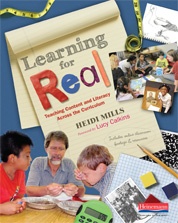 “Inquiry sounds rigorous and authentic, but it also sounds hard to manage.” As an advocate of learning through inquiry, I hear that a lot. I think it’s because inquiry seems too different from what many teachers currently do in their classroom. Yes, inquiry is different, but that doesn’t mean it’s too hard to do. Don’t believe me? Try this.
“Inquiry sounds rigorous and authentic, but it also sounds hard to manage.” As an advocate of learning through inquiry, I hear that a lot. I think it’s because inquiry seems too different from what many teachers currently do in their classroom. Yes, inquiry is different, but that doesn’t mean it’s too hard to do. Don’t believe me? Try this.
An easy way to introduce inquiry is to start your school day with an exploration (a curricular structure in which students work on projects of their choice) that transitions into morning meeting. Because there is often a significant time difference between when the first and last child arrive each morning, devoting the first half hour to exploration gives you a chance to touch base with each child and gives kids a chance to work independently or in small groups until everyone is assembled. It’s a calm, productive way to start the day.
Explorations are an opportunity for children to inquire about something that sparks their curiosity and will help them grow as learners and as people. The key is choice. Students read independently or together, work on pieces they are preparing for publication, play chess or other games, conduct experiments, and write observations or pose questions in a class journal. It’s not enough simply to offer diverse materials for children to explore, however. For explorations to be successful, teachers first need to introduce each activity individually and let students practice it as a class. Then, when children understand how to use a strategy or material, it is added to the class list of exploration choices. For example, Tim O’Keefe teaches his second and third graders how to play chess because it demonstrates the importance of developing strategies and promotes good sportsmanship. Chess becomes an exploration choice once Tim is confident his students understand how to play the game.
In this video clip, Tim and a small group of children collaboratively reconstruct the skeleton of a dead bat they had buried five months earlier.
Notice how Tim and his students exchange exploratory comments and questions, moving fluidly in and out of mentor and apprentice roles as they use the language of inquiry: I noticed... ; I wonder... ; I made a connection... ; I appreciated... ; I have a feeling... ; I was surprised by... ; This reminds me of...
What’s most striking is how individual insights become part of the collective understanding. The group members are reaching beyond their current understanding. They consult their classmate William, who knows a lot about bats from an expert project he completed in first grade. They also use nature magazines and the Internet to explore their emerging questions.
An inquiry-based biology unit launched this work, but units often emerge from what happens during an exploration as well. Let the process of inquiry inspire and inform you and your students.
For more on how to make inquiry work in your classroom, see Heidi’s new book, Learning for Real. The book and its companion resource, which includes teaching demonstrations and possible units, provide clear, actionable ideas on how to develop five habits of inquiry that define lifelong learning:
• Carefully observe the world using the tools and strategies of a discipline.
• Pose questions and investigate problems from numerous perspectives.
• Obtain information and evidence from primary and secondary sources, narrative as well as nonnarrative.
• Use the language of inquiry while reflecting on and sharing new learning with others.
• Employ reflection and self-evaluation to grow and change.


